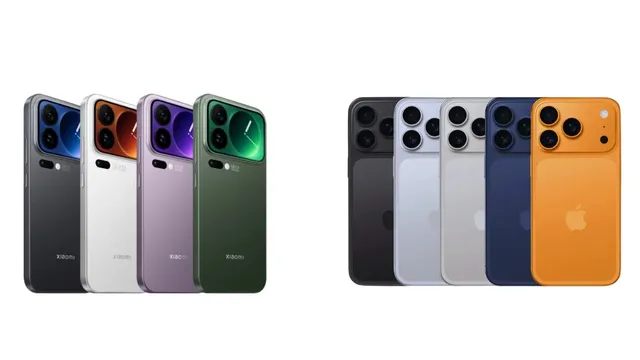- By Prateek Levi
- Sun, 05 Oct 2025 10:23 PM (IST)
- Source:JND
Apple and Xiaomi once again hog the limelight with their latest flagships — iPhone 17 Pro Max and Xiaomi 17 Pro Max. The two companies are competing for the same premium users: individuals seeking beauty, brawn, and first-rate performance in one package.
Apple carries on the tradition with the new A19 Pro chip, iOS 26, and a new chassis design. Xiaomi, however, has gone bold — bypassing its 16 series completely to directly battle Apple's 17 series. Its latest phone is filled with top-of-the-line upgrades, top-class display technology, and signature design features designed to make a statement.
ALSO READ: Vivo V60e 5G Vs V50e 5G: Key Upgrades You Need To Know
Display: Brilliance Meets Innovation
The iPhone 17 Pro Max boasts a 6.9-inch Super Retina XDR OLED display with a 120 Hz refresh rate, HDR, and the now-familiar True Tone and wide P3 colour gamut — an Apple standard for visual precision.
The 17 Pro Max of Xiaomi, however, is the same size as 6.9 inches and features a brighter AMOLED display covered in Longjing Glass 3.0 and reaching up to 3500 nits. It includes 1.5K resolution, HDR10+, Dolby Vision, and adaptive refresh rates between 1 Hz and 120 Hz.
But Xiaomi doesn't rest there—it includes a 2.7–2.9-inch secondary rear screen that is a selfie screen, mini clock, or even a retro-like gaming screen with its Game Boy add-on. Apple, on the other hand, remains with one refined display experience.
Camera: Precision vs Power
Apple remains with a well-tested triple-camera system — a 48MP primary lens, an ultra-wide sensor, and a telephoto lens with 4x optical zoom.
Xiaomi’s camera department looks more aggressive, pairing a Leica-tuned triple setup with a 50MP main sensor, a 50MP periscope lens offering 5x optical zoom, and an ultra-wide sensor. Selfie lovers will appreciate Xiaomi’s 50MP front shooter, while Apple retains its 18MP front camera for balanced performance.
Performance: Silicon Showdown
iPhone 17 Pro Max features the A19 Pro chip and comes with 12GB RAM and a maximum of 2TB storage. It keeps on providing seamless multitasking with its powerful vapour chamber cooling.
Xiaomi retaliates with the Snapdragon 8 Elite Gen 5, supporting up to 16GB RAM and 1TB of storage, fuelled by HyperOS 3 (Android 16-based). Both devices are monsters in daily usage, but Xiaomi leaves more room for customisation and additional RAM breathing space for gamers and creatives.
Battery and Charging: Endurance vs Speed
Apple covers its battery specs, but rumours indicate a 5,088 mAh one with 40 W wired and 15 W MagSafe wireless charging.
Xiaomi, on the other hand, makes no secret — its 7,500mAh battery is compatible with 100W wired, 50W wireless, and 22.5W reverse charging. The contrast is apparent: Xiaomi goes for plain battery life and quick top-ups, while Apple values balanced efficiency.
Design and Build: Classic Craft vs. Bold Experiment
Apple sustains its high-end strategy with a Ceramic Shield 2 coating and IP68 rating, providing strength with subtle sophistication.
Xiaomi takes a more experimental approach — bringing forth a dual-screen design with Dragon Crystal Glass and its own special Magic Back Screen. It's practical and fun for those who prefer that their phone be different and do something more than the norm.
Price: Flagship Prices, Various Strategies
Apple’s iPhone 17 Pro Max starts at ₹1,49,900 for the 256GB model. Xiaomi’s 17 Pro Max, currently available in China, is priced at CNY 5,999 (12GB + 512GB), CNY 6,299 (16GB + 512GB), and CNY 6,999 (16GB + 1TB).
Xiaomi’s aggressive pricing hints at a clear strategy — to offer a premium experience at a lower entry point while directly challenging Apple’s dominance.
ALSO READ: Moto G06 Power Teased For India Launch With A Massive 7000mAh Battery
Verdict
Both phones are designed for power users, but with vastly different principles. The iPhone 17 Pro Max takes everything Apple is about—polish, precision, and ecosystem dependability—to the next level. Xiaomi, on the other hand, introduces bold innovation, bleeding-edge hardware, and a dash of fun that could just tip users seeking something new.

